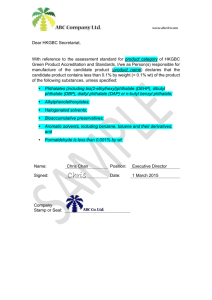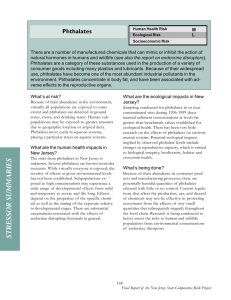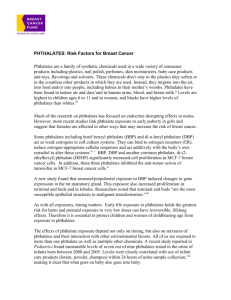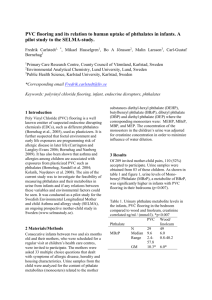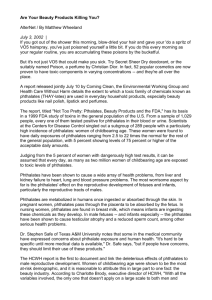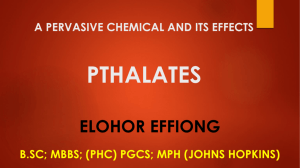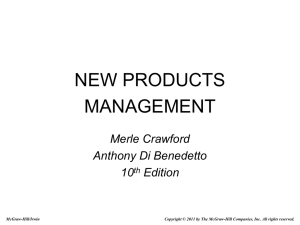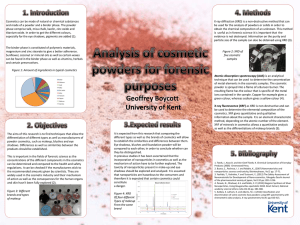Estimated exposure to phthalates in cosmetics and risk assessment
advertisement
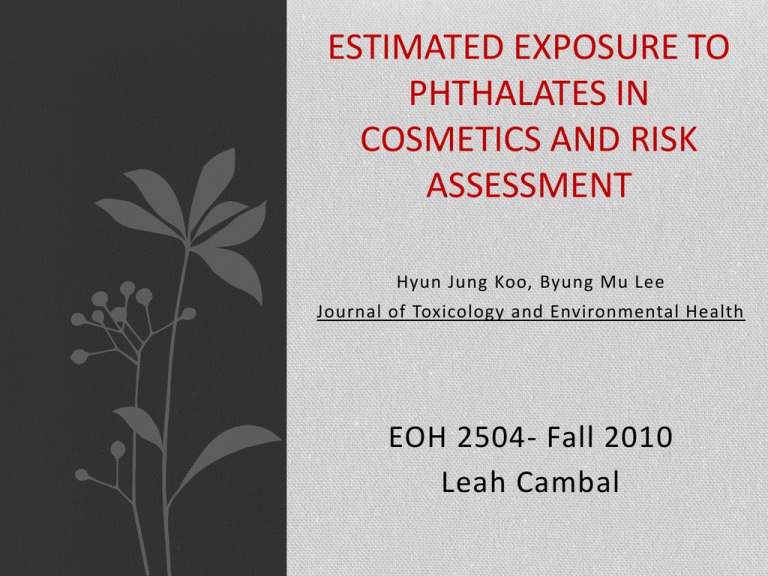
ESTIMATED EXPOSURE TO PHTHALATES IN COSMETICS AND RISK ASSESSMENT Hyun Jung Koo, Byung Mu Lee Journal of Toxicology and Environmental Health EOH 2504- Fall 2010 Leah Cambal Background on PHTHALATES • Widely used, multifunctional group of compounds • Used in industry and in a variety of consumer products • Approximately one billion tons produced per year worldwide • Dialkyl or alkyl aryl esters of 1,2-benzenedicarboxylic acid Why are they used? • Many beneficial chemical properties make them useful in a variety of applications • Excellent plasticizing properties -- increase flexibility, transparency, durability and longevity (original use - PVC) • Skin moisturizers (humectants) and skin softeners (emollients) • Agents to prevent brittleness and cracking (nail polishes and sealants) • Antifoaming agents (aerosols) • Solvents (wide range of applications) You may be surprised to learn… YOU ARE ALREADY FAMILIAR WITH PHTHALATES Phthalates are found everywhere. arcarpetbarn.com Not just in the products in which they are potentially used, but also as contaminants in just about anything. achooallergy.com supereco.com hk.sgs.com enviroblog.org cleanandhealthyme.org nutritionwonderland.com What are the.. HEALTH CONCERNS? • Existing literature focus • High level exposure for cancer endpoints • Occupational exposure leading to adult infertility • Recent studies, turning to low-dose toxicity of phthalates • Male reproductive development sensitive to some phthalates • In rats, suppression of the activity of aromatase , an important enzyme for masculinization of the male brain • Increase allergic reactions in mice to a dust mite allergen, may explain increased incidence of allergic reactions in countries with widespread phthalate use • Association between pregnant women’s exposure to phthalates and adverse effects on genital development in their male children Focusing on.. THE PAPER Objective Estimate individual exposures to phthalates in cosmetics Overview Measure the level of 4 phthalate diesters in 102 cosmetic products using high-performance liquid chromatography (HPLC). Use this quantified data to estimate individual exposure. Cosmetics 31 hair products, 42 perfumes, 8 deodorants, and 21 nail polishes Participants 150 women (aged 20-73 yrs) living in Suwon, Korea The Paper… 4 PHTHALATES OF INTEREST • Di(2-ethylhexyl) phthalate (DEHP) • Butyl benzyl phthalate (BBP) • Dibutyl phthalate (DBP • Banned in all toys and childcare articles in Europe • Limited to toys and childcare articles which can be placed in the mouth by children • Banned in cosmetics including nail polish • Considered to be carcinogenic, mutagenic, toxic to reproduction • Diethyl phthalate (DEP) • In 1995, DEP reported to be present in 67 cosmetic formulations, concentrations ranging from 0.1 to 50% • *In spite of their common occurrence in cosmetics and consumer products, little was known about human exposure to phthalates at this time* HPLC Analysis… RESULTS Levels of Phthalates in Cosmetic Products Types of DEHP DEP DBP BBP Products Perfume (42) 4.8% 57.1% 26.2% 4.8% Nail Polish (21) 9.5% 9.5% 90.5% 0% Hair Product (31) 0% 3.2% 0% 0% Deodorant (8) 0% 25% 0% 0% Phthalates with 0% levels were <LOD. For analysis purposes <LOD was considered to be halfway between 0 and the LOD values of each phthalate The Paper… FREQUENCY AND VOLUME OF COSMETICS USE • Cosmetics and hair products purchased at retail stores in Seoul, Korea • Questionnaire was used to determine the frequency and volume of cosmetics used TABLE 1. Frequency and Volume of Cosmetics Use Based on Questionnaire for 150 Users (Women, Aged 20-73 yrs) Frequency (times/day) / Volume (ml/time) Types of Perfume Hair Nail Deodorant Products Product Polish Mean ± SD 0.62/0.5 0.59/5 0.16/0.3 0.59/0.5 Maximum 5/5 3/20 2/2 2/3 Minimum 0/0 0/0 0/0 0/0 Median 1/1 1/10 1/0.5 1/1 90th 3/1.5 2/18 1/0.5 1/1 Percentile The Paper… ANALYSIS • Daily human exposure levels to phthalates were estimated from cosmetics using the following formula: • 𝐃𝐚𝐢𝐥𝐲 𝐇𝐮𝐦𝐚𝐧 𝐄𝐱𝐩𝐨𝐬𝐮𝐫𝐞 • • • • μg kg bw d μg = ml times C g V time F d Body Weight (kg) X Abs C is the concentration of phthalates in the products (µg/ml) V is the volume of cosmetics consumed per time (ml/time) F is the frequency of use (times/day) Abs is the absorption rate – Must Determine* *No human data was available on actual dermal absorption or inhalation at the given exposure scenarios. Absorption rates were extrapolated using animal data – with the help of 3 models. • Model 1 – Dermal Absorption • When only rat in vivo dermal absorption data was available, assumed human absorption is similar to that of a rat in terms of in vivo absorption • Model 2 – Dermal Absorption • Rat in vivo and human skin in vitro known find in vivo human abs • In vivo human abs. = In vivo animal In vitro human abs abs In vitro animal abs • Model 3 – Inhalation • Fragrance chemicals can enter the body by inhalation as well as dermally • Radiolabeled DEHP found to be absorbed in rats when exposed by inhalation Results… EXPOSURE LEVELS Estimated Median Exposure Levels to Phthalates Resulting from the Concurrent use of Multiple Cosmetic Products (µg/kg bw/d) DEHP DEP DBP BBP Dermal Inhalation Absorption 0.0006 0.026 0.6 81.471 0.103 22.917 N/A N/A Risk Assessment • • • Hazard Indices (daily exposure level/regulation level) determined for median inhalation exposure levels 0.0007 DEHP, 0.012 DEP, 0.347 DBP HI’s all far below 1, which implies daily exposure levels and regulation levels are equal The Paper… CONCLUSIONS •Study showed 4 individual phthalates present in cosmetics •No human data available, results extrapolated from animal data •BBP not found in nail polish, hair products, or deodorant • Median exposure levels and health indices not given •Hazard Indices suggest that estimated exposure to these 4 phthalates in the cosmetics studied are relatively small Assessment of the Paper • Estimation of daily human exposure and risk assessment based on the assumption that either dermal absorption or inhalation occurred • Does not reflect actual exposure scenarios • Many exposures from all different sources may be additive and a greater cause of concern than found in this study • Variation in method of using cosmetics • Perfume application to skin or clothes • Seemed to focus more on analytical work rather than exposure assessment • Questionnaire used to assess volume – another way? • Is this study generalizable? • Age range? References
